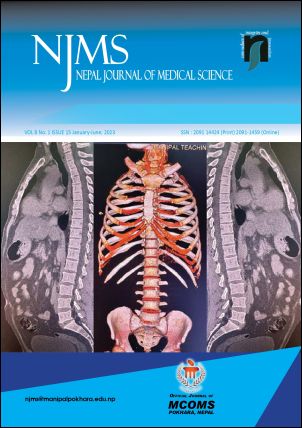Evaluation of Cesarean Deliveries by using Ten Group Classification System in a Tertiary Care Centre: A Cross-Sectional Study
DOI:
https://doi.org/10.3126/njms.v8i1.53655Keywords:
Cesarean Section, Cross-Sectional Studies, Trial of LaborAbstract
Introduction: Cesarean section has three times increased risk of maternal and fetal morbidities compared to vaginal delivery. The rising trend of cesarean deliveries across the globe led the WHO to recommend the use of the Ten Group classification system to monitor cesarean rate over time as well as between facilities. The cesarean section rate is increasing in our centre, so the study was conducted to evaluate the cesarean deliveries and identify the group with a major contribution to the cesarean rate so that policies could be formulated to decrease it in our centre.
Method: It was a cross-sectional descriptive study conducted in the Department of Obstetrics and Gynecology, Manipal Teaching Hospital, Nepal for six months after ethical approval. All women who delivered at or beyond 28 weeks were included in the study after their consent and were classified according to Robson's classification based on their obstetric parameters. The total cesarean section rate, the size of each group, the cesarean rate in each group and the absolute contribution of each group to the overall cesarean rate were calculated and analyzed.
Results: Out of 711 deliveries during the study period, the cesarean rate was 51% (n=362). Group 1(26%) was the major obstetric population followed by Group 3(20%) and Group 2(16%). Group 5(10.97%) had a major contribution to the overall cesarean rate followed by Group 1(10.68%) and Group 2 (9.7%).
Conclusion: The cesarean rate in our study was high and it could be decreased by encouraging the trial of labor after cesarean and revisiting the indication of induction and cesarean in Group 1 and Group 2.
Downloads
Downloads
Published
How to Cite
Issue
Section
License
Copyright (c) 2023 Nepal Journal of Medical Sciences

This work is licensed under a Creative Commons Attribution 4.0 International License.
Copyright © by Nepal Journal of Medical Sciences. The ideas and opinions expressed by authors of articles summarized, quoted, or published in full text in this Journal represents only opinions of authors and do not necessarily reflect the official policy of Nepal Journal of Medical Sciences or the institute with which the author(s) is (are) affiliated, unless so specified.




